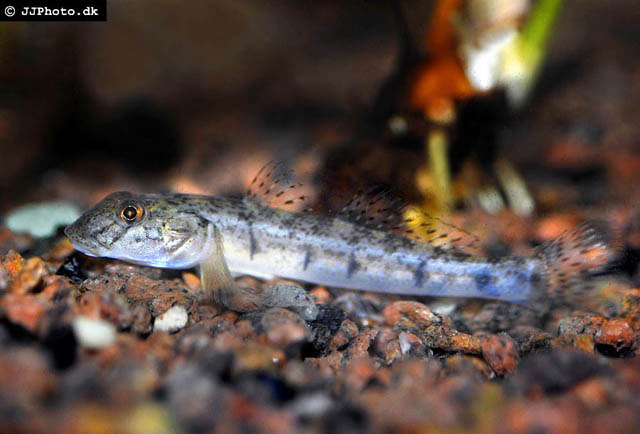| Gobiidae (Gobies), subfamily: Gobionellinae |
| 13.98 cm SL (male/unsexed) |
|
demersal; freshwater; brackish, amphidromous |
| Eastern Atlantic: St. Louis (Senegal) to the Cunene River (Angola) and from the islands of the Gulf of Guinea (Ref. 5299, 57403, 79590). Also reported from the lower Kunene in Namibia (Ref. 33857). |
|
Dorsal spines (total): 7-7; Dorsal soft rays (total): 10-11; Anal spines: 1-1; Anal soft rays: 9-11. Diagnosis: snout 33-38% of head length; mouth with 2-3 rows of small, caniniform teeth; head length 24-31% of standard length; 2 fleshy processes on posterior of gill chamber, just inside gill opening; 35 or less cycloid predorsal scales, extending to vertical level of posterior part of preoperculum, predorsal scales may rarely be absent; cheeks and operculum naked; body with strongly ctenoid scales, numbering 54-66 (usually 59 to 63) in longitudinal series (including usually 3-4 scales on caudal fin base); 13-20 scales in rearward transverse series; 16-21 scales around caudal peduncle; 1st dorsal fin: VI; second dorsal fin: I,10 (rarely 11); anal fin: I,9-11 (usually 10), opposed to 2nd dorsal fin; pectoral fins: 14-17; caudal fin: 17 segmented rays (11 to 13 of which are branched); pelvic fins oval; yellowish dorsally, with several (about 14) bands of brown spots over dorsum (Ref. 57403, 79590).
Description: oculoscapular canal almost always continuous (Ref. 57403, 79590), from anterior nostril to rear margin of the opercle (Ref. 79590), incorporating pores A, B, C (double), D (single), F (single), G, H (not always apparent), J, K and L (Ref. 57403). Upper jaw slightly hangs over lower jaw; upper lip thick; head broader than deep; caudal fin rounded (Ref. 4967, 13444).
Coloration: Preserved specimens: head with approximately 4 bands of brown spots running anteroventrally from suborbital and upper preopercular regions towards jaws; upper part of operculum with a few brown spots; nape with several, distinct brown spots; body yellowish dorsally, with several (about 14) bands of brown spots on dorsum; flanks bearing 5-10 brown patches near lateral midline, last is close to base of caudal fin; ventral surface of body pale whitish; dorsal fins pale, with marbled brownish areas; anal and pelvic fins pale; pectoral fin pale but with some brown speckling forming vague bands on dorsal parts of fin; caudal fin with at least 3 cross bars consisting of brown dots; juvenile fish, <20 mm SL, often with a large, dark spot on posterior part of base of 1st dorsal fin and flanks with distinct dark bars which fade to become the brown patches near the lateral midline in larger fish (Ref. 57403, 79590). In life: body grayish, or perhaps purplish above lateral midline, with white bands on midline and some golden spots on dorsum; bright white marks on dorsal and caudal fins; anal and pelvic fins with white distal margin; spots on body and fins carmine-red to purple-red (Ref. 57403, 79590). |
| Amphidromous freshwater species (Ref. 92840). Often found in lower courses of rivers, ranging from freshwaters to brackish habitats (Ref. 57403, 79590), including brackish waters of intermittent streams during dry seasons (Ref. 5299), but may ascend far up rivers (Ref. 57403, 79590). Also found in flooded fields and marginal swamps along courses of streams and rivers (Ref. 5299). Not usually exceeding 139.8 mm SL, larger specimens may be misidentifications of A. bustamantei (Ref. 79590). |
|
Least Concern (LC); Date assessed: 12 May 2019 Ref. (130435)
|
| harmless |
Source and more info: www.fishbase.org. For personal, classroom, and other internal use only. Not for publication.

